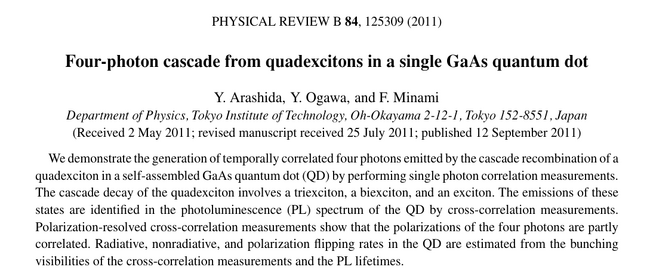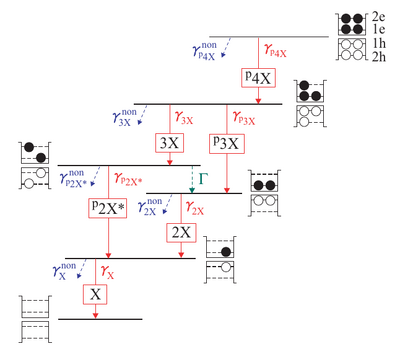(Quadexciton cascade) |
m |
||
| Line 10: | Line 10: | ||
<center><wz tip="The power of the method illustrated.">[[File:Screenshot_20240722_162251.png|400px]]</wz></center> | <center><wz tip="The power of the method illustrated.">[[File:Screenshot_20240722_162251.png|400px]]</wz></center> | ||
| − | <center><wz tip="Extract of some cross-correlations, showing bunching or incompatible transitions, e.g., 2X* | + | <center><wz tip="Extract of some cross-correlations, showing bunching or incompatible transitions, e.g., 2X*→X is bunched but 2X*→2X is antibunched, as is clear from the energy levels.">[[File:Screenshot_20240722_153806.png|400px]]</wz></center> |
Non-contiguous cascades still show bunching, but those that require to take another route altogether, show antibunching. They did not consider three or higher photon correlations but derived everything pairwise. | Non-contiguous cascades still show bunching, but those that require to take another route altogether, show antibunching. They did not consider three or higher photon correlations but derived everything pairwise. | ||
Revision as of 14:32, 22 July 2024
Four-photon cascade from quadexcitons in a single GaAs quantum dot. Y. Arashida, Y. Ogawa and F. Minami in Phys. Rev. B 84:125309 (2011). What the paper says!?

This studies two-photon correlations in a four-photon cascade from a quadexciton (four excitons):

By looking at cross-correlations between various peaks, they can identify cascades or, on the opposite, incompatible transitions (possibly complemented with polarization correlations):


Non-contiguous cascades still show bunching, but those that require to take another route altogether, show antibunching. They did not consider three or higher photon correlations but derived everything pairwise.
This is done under pulsed excitation, which provides only partial information, but is complemented by time-resolved PL, which is a form of $g^{(2)}(\tau)$.
Their Section C. "Radiative and nonradiative rates" makes interesting manipulations of bunching ratios to derive systems parameters (nonradiative vs radiative rates), apparently derived from Koruda et al.[1].
Due to circular polarization being lost, the Authors also conclude that four-photon polarization correlations cannot be sustained.